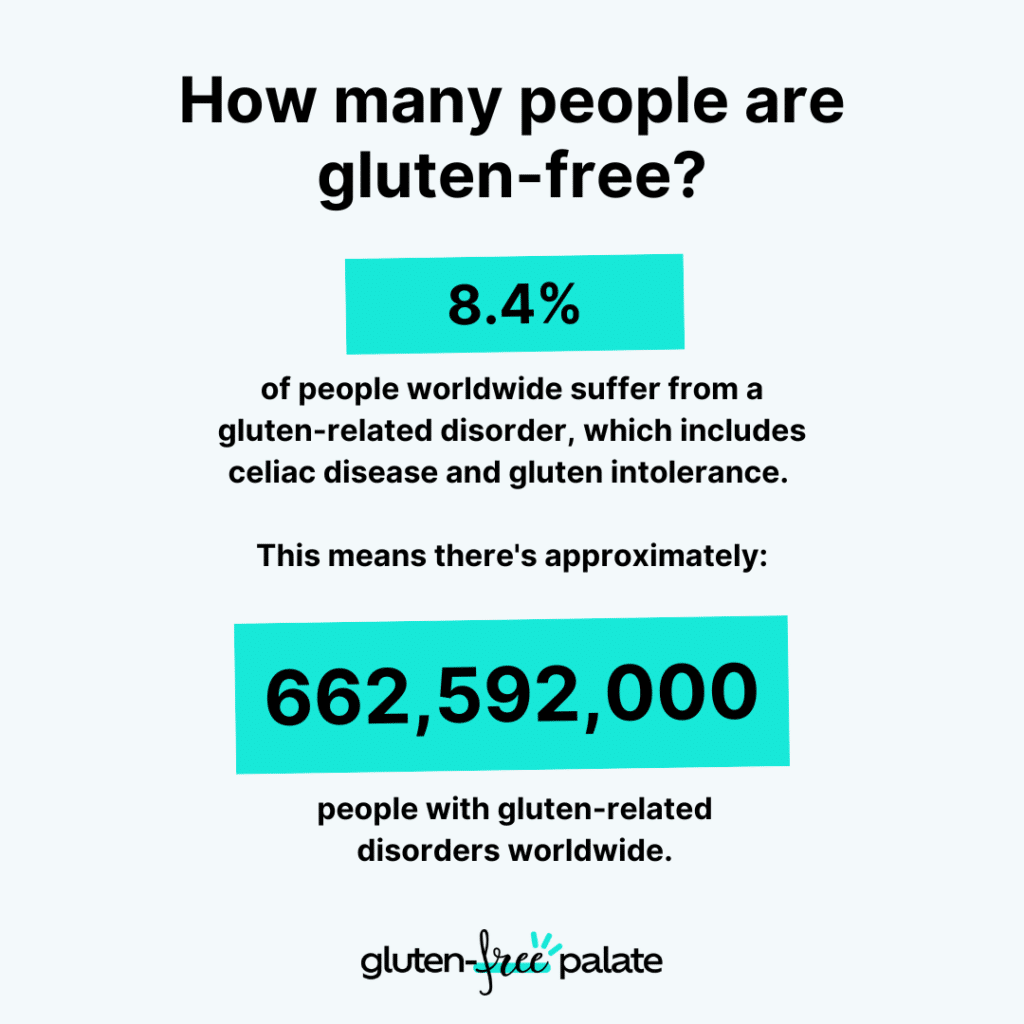Grab your favorite gluten-free snack and settle in for this gluten-free statistics guide. It includes the most up-to-date information about celiac disease, gluten intolerance, and gluten-free living worldwide.
What these gluten-free stats tell us is that you’re not alone if you follow a gluten-free diet. There are people worldwide on this journey with you, and many countries are making it easier to live a healthy gluten-free lifestyle.
How Many People Are Gluten-Free?
What percentage of people are gluten-free? Approximately one percent of the world’s population has celiac disease and thus follows a gluten-free diet. However, 8.4 percent of people worldwide suffer from a gluten-related disorder, which includes celiac disease and gluten intolerance. Considering the world population is currently 7.88 billion, this means there’s more than 660 million people with gluten-related disorders worldwide.

This is different from how many people are gluten intolerant, though. According to the Cleveland Clinic, approximately six percent of Americans are gluten intolerant (nearly 20 million people).
Gluten-Free Statistics
Ready to deep dive into some gluten-free trends, facts, and figures?
Key Celiac Demographics
Let’s break down the most common people with celiac disease:
- Millennials are the most common demographic following a gluten-free diet.
- Between 60 and 70 percent of people diagnosed with celiac disease are females.
- 17 per 100,000 women have celiac disease compared to 8 per 100,000 men. They’re most commonly diagnosed when they’re between 40 and 60 and approaching menopause.
- The average age of diagnosis is 50.
- Celiac disease is more prevalent in children than adults. 21 per 100,000 children have celiac disease compared to 13 per 100,000 adults.
- Celiacs are most commonly from North Africa, India, Finland, or the United States.
- The prevalence of celiac disease is 0.4% in South America, 0.5% in Africa and North America, 0.6% in Asia, and 0.8% in Europe and Oceania.
- The most common ethnicity is Caucasian. In the United States, non-Hispanic white people are four to eight times more likely to be diagnosed with celiac disease.
- The number of people with celiac disease has been growing at an average rate of 7.5% annually for the past several decades.
Why Are People on a Gluten-Free Diet?
These are the most common reasons people follow a gluten-free diet:
- 48% of people are on a gluten-free diet because of celiac disease.
- 31% follow a gluten-free diet because of gluten intolerance.
- 8.4% follow a gluten-free diet because of a different auto-immune disease.
- 80% of gluten-free consumers are trying to manage gastrointestinal pain.
But Wait, There’s More
Unfortunately, a lot of people with celiac disease get the added bonus of being diagnosed with a further allergen or disease:
- Approximately 69% of people with celiac disease have anemia.
- 28% of people following a gluten-free diet are also allergic to dairy.
- 27% of celiacs have lymphocytic colitis (inflammation of the large intestine).
- 10% of celiacs have Type I Diabetes.
The Expanding Gluten-Free Market
The global gluten-free product market is expected to be worth a staggering $43 billion in 2027.
In 2021, North America (closely followed by Europe) had the highest sales of gluten-free products (nearly 37 percent). 57 percent of the gluten-free food market is bakery items. These gluten-free statistics show companies it’s worthwhile boarding the gluten-free train and you can expect the market to expand substantially over the next few years.
Speaking of, the global gluten-free beer market is predicted to increase at a compound annual growth rate of 13.72% between 2018 and 2028. As for the food market, gluten-free dishes currently appear on 26 percent of US restaurant menus.
Gluten-Free Shopping
As you probably know, it’s not the easiest to be gluten-free. According to the Celiac Disease Foundation, it’s basically impossible to completely avoid gluten, as it’s included in 80% of food products.
23% of Americans are regularly shopping for gluten-free products. Two out of every three prefer to buy products with a Gluten-Free Certification Organization label instead of reading the ingredients to make their own determination.
Waiting Game
According to Beyond Celiac, people wait six to 10 years to be correctly diagnosed with celiac disease. Of this, up to 83% of Americans with celiac disease are either undiagnosed or misdiagnosed with other conditions.
One of the main reasons is that 60% of children and 40% of adults with celiac disease have no symptoms. There are over 200 symptoms of celiac disease. This includes abdominal pain, bloating, fatigue, headaches, anemia, joint pain, and nausea.
Globally, up to 90% of people don’t realize they have celiac disease. Yet the Mayo Clinic found that 44 percent of screened first-degree relatives had celiac disease. So when one has it, another typically isn’t (biologically) far away.
The Gluten-Free Burden
Being diagnosed with celiac disease can be a burden in more than one way.
- The financial pressure is an average of $2000 annually compared to those without celiac disease.
- Celiacs miss an average of 23 days of work or school annually due to a related illness.
- The most common challenges for following a gluten-free diet include the cost of gluten-free products, being required to pre-plan meals in advance, social restrictions, the risk of cross-contamination, and the availability of gluten-free options.
The Best (and Worst) Gluten-Free Countries
Here are the five best countries where people commonly follow a gluten-free diet and there are plenty of gluten-free products available.
The Best Gluten-Free Countries
Italy
You wouldn’t believe Italy, with its pizza and pasta, is one of the best gluten-free countries. But it’s true. The Italian government has imposed strict regulations regarding food allergies and intolerances, so the country is very accommodating to people with celiac diseases. Across Italy, there are gluten-free bakeries, restaurants, and shops.
Mexico
Mexico is a great country for gluten-free consumers because Mexican cuisine is naturally predominantly gluten-free. Tacos, tamales, enchiladas, and huevos rancheros are all mostly corn-based meals, which makes eating gluten-free so much easier and safer.
United States of America
As mentioned, approximately one percent of Americans have celiac disease. With the gluten-free product market being valued at $4.3 billion in 2019, rest assured you’ll find gluten-free products in supermarkets country-wide. There are also gluten-free restaurants everywhere, from NYC to Las Vegas.
Related: If you need help living a gluten-free lifestyle in the States, these gluten-free apps are actual lifesavers. Trust us.
Ireland
With approximately 100,000 people in Ireland living with celiac disease and 450,000 living with gluten intolerance, the country is no stranger to the gluten-free diet. You’ll find gluten-free options at restaurants, supermarkets, and even gas stations.
Finland
Finland is actually nicknamed Celiac World HQ, where an estimated 2.4 percent of adults and one in every 99 children have celiac disease. Local restaurants take celiac disease seriously and you’ll find several solely focus on gluten-free food or offer gluten-free substitutes. There are also plenty of gluten-free options in supermarkets.
The Worst Gluten-Free Countries
In contrast, here are the five worst countries if you’re gluten-free that don’t have a lot of gluten-free consumers.
Taiwan
The gluten-free trend hasn’t quite made its way to Taiwan and other Asian countries. While there are some exclusively gluten-free restaurants and products, there are definitely not as many as in other countries. A lot of Taiwanese food is fried in gluten or made with soy sauce, which we know isn’t naturally gluten-free. Gluten-intolerant Taiwanese typically stick to rice dishes and avoid noodles.
China
China is the same as Taiwan, just on a much bigger scale. Previously, it was also really difficult to get tested for celiac disease in China besides at-home kits. Fortunately, the country is slowly catching up to others. But the difference between the country’s size and the number of gluten-free options is worrisome. Chinese cuisine is full of glutinous items like noodles and dumplings and there isn’t an extensive range of gluten-free products in supermarkets.
Japan
Gluten-free and other dietary restrictions aren’t exactly prevalent in Japan in 2024. In fact, Japanese health insurance doesn’t even cover the test to confirm celiac disease. Now, some restaurants have realized there’s a market for gluten-free food. But in the wider hospitality industry, the knowledge of gluten allergies and cross-contamination is relatively low and not closely monitored. A lot of products are processed with wheat and covered in soy sauce, too.
Cook Islands
There aren’t a lot of gluten-free residents in the Pacific Islands (from the Cook Islands to Fiji) and most countries don’t have strict gluten-free policies like the United States. So while a dish might be labeled gluten-free, it’s best to always ask restaurants in the Cook Islands to confirm how they prepare their gluten-free food.
Morocco
North Africa (countries like Morocco, Egypt, Algeria, and Tunisia) actually has the second-highest number of people with gluten intolerance. But it’s not easy to follow a gluten-free diet in Morocco. You have to visit larger supermarkets like Carrefour to purchase their modest number of gluten-free products that are substantially more expensive. Wheat is also a staple in Moroccan cuisine and not many restaurants offer gluten-free items.
Related: Do you know what goes hand-in-hand with the worst gluten-free countries? The worst gluten-free foods. These are a no-go zone (your gut will thank you).
Frequently Asked Questions
How Many People Are Gluten-Free Compared to Other Diets?
Approximately 4 in 10 Americans followed a diet or specific eating pattern in 2021. So let’s compare gluten-free statistics to other diets:
SUNY estimates that between one and three million Americans follow the paleo diet. If you didn’t know, paleo refers to the Paleolithic era and people eating the unprocessed food a caveman would’ve eaten, like meat, fruit, vegetables, and nuts.
12.9 million Americans follow the keto diet, and the global keto diet market is valued at over $10 billion. Keto is a low-carb and high-fat diet.
When you reduce your carbs your body enters into a metabolic state called ketosis, hence the name.
Why Is Gluten-Free So Common Now?
Gluten-free is becoming more common because more people worldwide are being diagnosed with celiac disease thanks to better testing. As you can see from the above stats on the gluten-free diet, gluten intolerance is also a big concern.
The other reason gluten-free is more common is that these days, many people’s diets include a lot of heavily-processed foods that contain gluten. This includes bread, pizza, pancakes, crackers, and pastries.
What Percentage of the US Population Is Gluten Intolerant?
Six percent of Americans are gluten intolerant and approximately one percent have celiac disease.
What Ethnicity Is Most Gluten Intolerant?
The most gluten-intolerant ethnicity is Caucasian, followed by Hispanic.
What Nationality Has the Most Gluten Intolerance?
Indians have the most gluten intolerance, closely followed by North Africans.
Related: 20 Best Gluten-Free Indian Recipes
Gluten-Free Facts and Figures
We hope these gluten-free statistics give you a better understanding of gluten-free living worldwide. But with the gluten-free market booming right now, here’s hoping it’s easier and safer to eat gluten-free in future years.
Looking to become a gluten-free master? Check out the top 10 best gluten-free cooking classes online. One of our favorites is this gluten-free artisan breads course.








Leave a Question or Comment